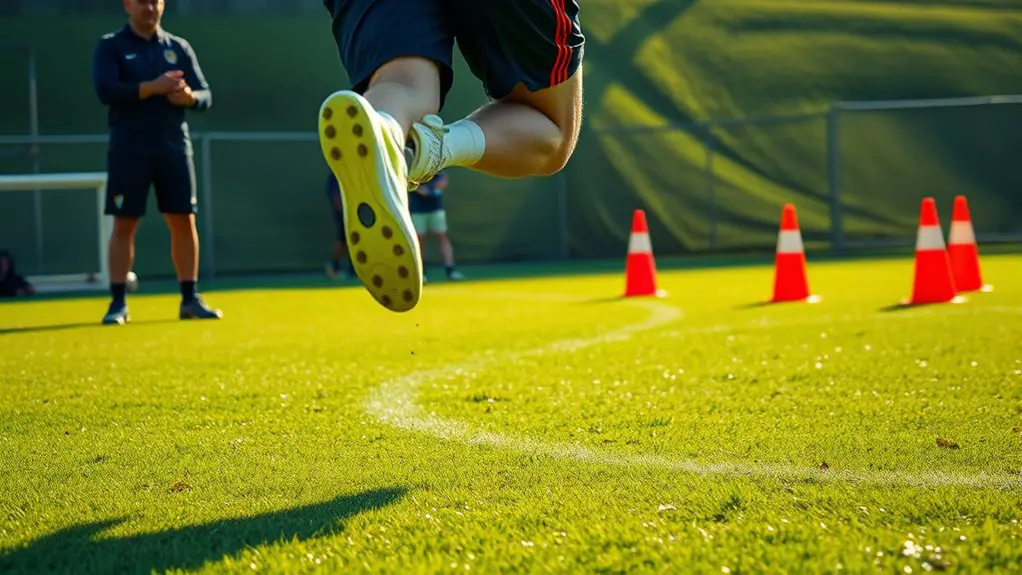Depth jumps greatly enhance power development by utilizing the stretch-shortening cycle, triggering quick muscle contractions following a rapid stretch. This process boosts explosive strength, improving your athletic performance in various sports. By promoting neuromuscular adaptations, depth jumps help you generate force more efficiently and respond faster. Plus, they offer superior explosiveness compared to other training methods. If you're curious about how to integrate depth jumps effectively into your workouts, there's more to discover.
Understanding the Stretch-Shortening Cycle
When you think about athletic performance, the stretch-shortening cycle (SSC) plays an essential role in how your muscles generate power. The SSC combines a rapid stretch of your muscles with a quick muscle contraction, allowing for explosive movements that can enhance your freedom of movement in sports. When you land from a jump, your muscles experience a stretch reflex, which triggers an immediate contraction. This reaction not only helps absorb the impact but also primes your muscles for a powerful push-off. Embracing this natural cycle can elevate your performance, whether you're sprinting, jumping, or changing direction. By understanding and training the SSC, you're revealing your body's potential, enabling you to move more fluidly and effectively. This knowledge empowers you to harness your body's mechanics, making every jump and sprint a chance to maximize your athletic prowess. Additionally, training with plyometric exercises can significantly improve your overall power output. So, get ready to explore the exhilarating world of movement!
Physiological Mechanisms of Depth Jumps
Depth jumps are a powerful training tool that taps into the physiological mechanisms of the stretch-shortening cycle. When you perform these jumps, your muscles experience mechanical loading, which triggers a rapid stretch followed by a powerful contraction. This process enhances your ability to generate force quickly, making each jump more explosive.
As you continue to train, your body adapts through neuromuscular adaptations, improving your coordination and muscle efficiency. These changes allow for better force production and quicker response times, giving you the freedom to perform at higher levels in your sport or activity. Furthermore, incorporating plyometric exercises into your routine can significantly elevate your explosive power and athletic performance.
Comparing Depth Jumps to Other Training Modalities
While many training modalities aim to enhance power and explosiveness, depth jumps stand out due to their unique engagement of the stretch-shortening cycle. When comparing depth jumps to other methods, like traditional plyometrics, you'll find some notable advantages.
| Training Modality | Focus | Depth Jump Advantages |
|---|---|---|
| Depth Jumps | Reactive strength | Enhanced power output |
| Plyometrics | Jumping and bounding | Increased explosiveness |
| Olympic Lifts | Overall strength development | Targeted muscle engagement |
| Sprinting | Speed and acceleration | Improved vertical leap |
Depth jumps not only improve your vertical leap but also enhance your overall explosiveness more effectively than many other modalities. By incorporating depth jumps into your training routine, you embrace a method that maximizes your potential for power development, offering a unique edge in your athletic pursuits. Additionally, plyometric exercises specifically designed to engage fast-twitch muscle fibers can further complement the benefits of depth jumps.
Benefits of Depth Jumps for Different Sports
Incorporating depth jumps into your training can yield significant benefits across various sports. For basketball performance, these explosive movements enhance your vertical leap, allowing you to reach for that rim with more power. Track sprinters can also see improvements in their acceleration and speed, as depth jumps train the muscles to react faster off the starting blocks. If you're into volleyball, depth jumps can elevate your ability to execute those critical volleyball jumps, giving you an edge in spikes and blocks. Meanwhile, football players experience a boost in explosiveness, making those tackles and breakaways more dynamic. The versatility of depth jumps makes them an excellent addition to any athlete's regimen, promoting not just strength but the kind of agility and power that can transform your game. Additionally, incorporating plyometric exercises for explosiveness can further enhance your training results, as they develop rapid power generation. So, whether you're on the court, track, or field, depth jumps can definitely take your performance to the next level.
Practical Applications and Training Considerations
To maximize the benefits of depth jumps, it's crucial to evaluate practical applications and training guidelines that align with your specific sport and skill level. Start by incorporating progressive overload into your training regimen. This means gradually increasing the intensity, volume, or complexity of your depth jumps to continue challenging your body and promote power development.
Consider your training frequency as well; aim for 2-3 sessions per week, ensuring you allow adequate recovery between workouts. This balance helps prevent fatigue while optimizing performance gains. Incorporating plyometric exercises alongside depth jumps can further enhance your explosive power.
You might also want to integrate depth jumps with other plyometric exercises to create a dynamic training program. Remember, it's all about finding what works for you—listen to your body and adjust your routine accordingly. Stay flexible, and don't hesitate to modify your approach as you progress. Embrace the journey, and enjoy revealing your full athletic potential!
Frequently Asked Questions
How Often Should Depth Jumps Be Incorporated Into Training Programs?
When considering how often to incorporate depth jumps into your training program, think about your overall training frequency and program variation. You don't want to overdo it, so aim for about 1-2 times a week, allowing your body to recover. Mixing in different exercises keeps things fresh and exciting, helping you stay engaged. Remember, it's all about finding what works for you while still pushing your limits and enjoying the freedom of your training.
What Is the Ideal Height for Depth Jumps for Beginners?
When you're starting your journey into depth jumps, beginners should stick to a safe six to twelve inches. This modest height helps you master the jump techniques without risking injury. Keep in mind these beginner guidelines encourage proper form, ensuring your body adapts gradually. Embrace the freedom to explore your limits, but always prioritize safety. As you grow stronger, you can soar to greater heights, enhancing your explosive power along the way.
Can Depth Jumps Cause Injury if Performed Incorrectly?
Yes, depth jumps can cause injury if you don't use proper jump technique. It's essential to focus on injury prevention by ensuring your landing is controlled and your form is correct. If you rush into it or use too much height, you might strain your joints or muscles. Take your time to master the technique, and don't hesitate to seek guidance. Remember, achieving your fitness goals should never come at the cost of your well-being!
Are There Age Restrictions for Performing Depth Jumps?
There aren't strict age restrictions for performing depth jumps, but it's essential to take into account the individual athlete's maturity and strength. For youth athletes, safety precautions are critical. You should make sure they're physically prepared and have a solid foundation in strength training. Encouraging freedom in their training is great, but don't overlook the importance of proper technique and progressive training to reduce the risk of injury. Always prioritize safety while allowing them to explore their capabilities.
How Do Depth Jumps Affect Overall Athletic Performance?
Ever wonder how a simple jump could transform your athletic performance? Depth jumps can greatly enhance your power output and explosive strength. As you land and rebound, your muscles adapt, leading to greater force production. This isn't just about how high you can jump; it's about releasing your potential. With consistent training, you'll feel the difference in your speed, agility, and overall performance, giving you the freedom to excel in your sport.




